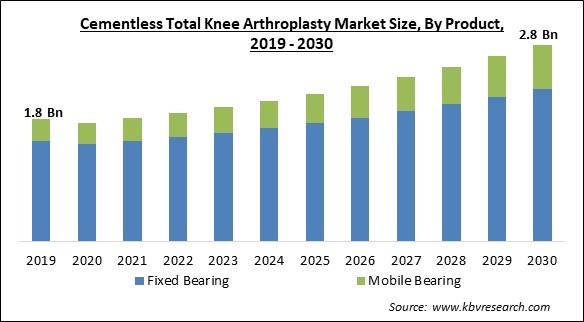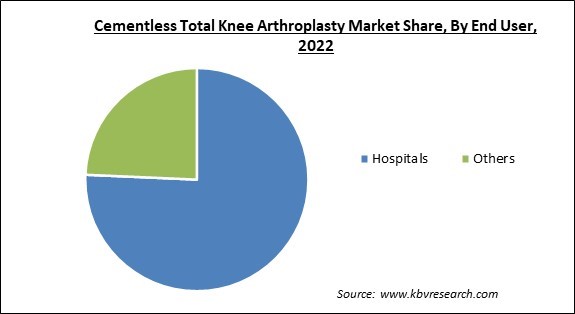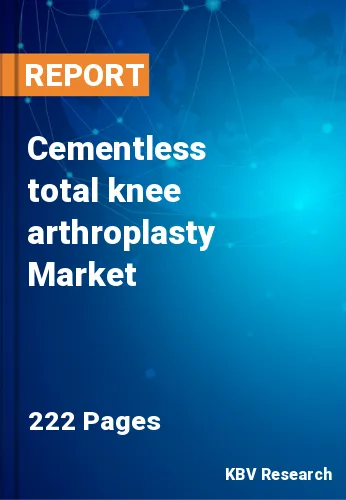The Global Cementless Total Knee Arthroplasty Market size is expected to reach $2.8 billion by 2030, rising at a market growth of 5.6% CAGR during the forecast period.
With aging, a substantial decrease is seen in bone mass or bone density in people. Calcium is among the minerals lost from the bones and the joints get stiffer and less flexible. Therefore, the Alloys segment would obtain around 60% share in the market by 2030. The United Nations reported that in 2019, globally around 703 million people were 65 or older. As people age, a variety of diseases and issues can arise. Most illnesses that affect seniors have a significant immunological component. Due to alloys' many advantages, including their biocompatibility with human tissue, enhanced implant fixation, and superior wear resistance, the market is expanding. Some of the factors impacting the market are the increase in prevalence of orthopedic conditions, growing demand for knee implants made with 3d printing and high price of cementless total knee arthroplasty.

Because musculoskeletal disorders and orthopedic injuries like tendinitis (tendonitis), osteoarthritis, and ligament injuries are becoming more common, orthopedic regenerative surgery therapies are in great demand. An anterior cruciate ligament (ACL) injury is one of the wounds that has been the subject of extensive orthopedic therapy and study. These mishaps are occurring more frequently in professional football. The trend is increasing as a result of bigger, faster players. Arthritis strikes frequently, with serious personal and societal repercussions. Furthermore, in addition to producing standard-sized knee surgical implants, patient-specific implants for persons with typical joint and bone anatomy, along with custom 3D-printed implants for those with bone or joint malformations, 3D printing is now frequently employed to create orthopedic devices. Doctors may create personalized knee implants using any geometric feature or complex shape due to 3D printing's additive manufacturing technology. Thus, the market will rise in the coming years due to the expansion of these conditions and increased product demand and the increasing use of 3D printing in developing implants has proven beneficial to market growth.
However, cementless total knee arthroplasty faces a number of significant obstacles on a global scale. The most significant of these challenges are the high costs of medical treatment and the postoperative care that follows cementless knee implants. A TKA can typically cost between $30,000 to $50,000 in the United States. Cementless TKA is more difficult to perform than cemented arthroplasty, and knee implants for cementless procedures are more progressed than cemented knee implants. Cementless TKA is, therefore, much more expensive. This restricts the use of total knee arthroplasty (TKA) and thus hampers the growth of the market.
Moreover, due to the widespread spread of COVID-19, the market for cementless total knee arthroplasty was significantly impacted, with lower demand and fewer patients attending hospitals. The pandemic stopped everything, including transportation and manufacturing. All implanted product segments saw a decline in demand due to the stringent lockdowns and government measures designed to stop the spread of COVID-19. As a result, the pandemic negatively impacted the market's growth in its early stages. The adoption of cementless TKA in post-pandemic stages is also increasing due to the shorter recovery time, abundant bone supply, lack of issues from cement fixing, and ease of revision.
By end user, the market is divided into hospitals and others. The others segment garnered a remarkable growth rate in the market in 2022. Due to an increase in patient demand for outpatient surgeries at ambulatory surgery centers (ASCs) and orthopedic clinics, the segment is expanding. Additionally, the expansion of ASCs for treating orthopedic patients is anticipated to drive the market during the forecast period.

Based on product, the market is characterized into mobile bearings and fixed bearings. The fixed bearings segment garnered the highest revenue share in the market in 2022. The fixed-bearing platform, which is utilized as a standard for numerous cementless TKA implants due to its straightforward design and inexpensive cost, is one of the benefits offered by this segment that is driving its growth. Highly cross-linked polyethylene for implants has been created by researchers. It lessens the possibility of surface wear and oxidation, making fixed-bearing implants dependable.
On the basis of material, the market is classified into ceramics, alloys, and others. The alloys segment acquired the largest revenue share in the market in 2022. Due to alloys' many advantages, including their biocompatibility with human tissue, enhanced implant fixation, and superior wear resistance, the market is expanding. The implant's metal components are created from alloys based on titanium or cobalt-chromium. Medical-grade polyethylene is used to make plastic components.
| Report Attribute | Details |
|---|---|
| Market size value in 2022 | USD 1.8 Billion |
| Market size forecast in 2030 | USD 2.8 Billion |
| Base Year | 2022 |
| Historical Period | 2019 to 2021 |
| Forecast Period | 2023 to 2030 |
| Revenue Growth Rate | CAGR of 5.6% from 2023 to 2030 |
| Number of Pages | 222 |
| Number of Table | 330 |
| Report coverage | Market Trends, Revenue Estimation and Forecast, Segmentation Analysis, Regional and Country Breakdown, Companies Strategic Developments, Company Profiling |
| Segments covered | Product, Material, Application, Region |
| Country scope | US, Canada, Mexico, Germany, UK, France, Russia, Spain, Italy, China, Japan, India, South Korea, Singapore, Malaysia, Brazil, Argentina, UAE, Saudi Arabia, South Africa, Nigeria |
| Growth Drivers |
|
| Restraints |
|
Region wise, the market is analyzed across North America, Europe, Asia Pacific, and LAMEA. The North America segment procured the highest revenue share in the market in 2022. The government's Medicare program, which pays for the majority of medical services, surgeries, and orthopedic implants, is responsible for publicly funded healthcare systems. In addition, compared to other nations in the region, the total number of patients getting total knee arthroplasty is very high in wealthy nations like the U.S. and Canada. Such factors are boosting the demand for cementless TKA procedures in this region.
Free Valuable Insights: Global Cementless total knee arthroplasty Market size to reach USD 2.8 Billion by 2030
The market research report covers the analysis of key stake holders of the market. Key companies profiled in the report include Johnson & Johnson, B. Braun Melsungen AG, Smith & Nephew PLC, Stryker Corporation, Olympus Corporation, Zimmer Biomet Holdings, Inc., MicroPort Scientific Corporation, United Orthopedic Corporation (Chi-Yi Investment Co. Ltd.), X.NOV and Waldemar Link GmbH & Co. KG.
By Product
By End User
By Material
By Geography
This Market size is expected to reach $2.8 billion by 2030.
Increasing prevalence of orthopedic conditions are driving the Market in coming years, however, High price of cementless total knee arthroplasty restraints the growth of the Market.
Johnson & Johnson, B. Braun Melsungen AG, Smith & Nephew PLC, Stryker Corporation, Olympus Corporation, Zimmer Biomet Holdings, Inc., MicroPort Scientific Corporation, United Orthopedic Corporation (Chi-Yi Investment Co. Ltd.), X.NOV and Waldemar Link GmbH & Co. KG.
The expected CAGR of this Market is 5.6% from 2023 to 2030.
The Hospitals segment is leading the Market by End User in 2022; thereby, achieving a market value of $2.0 billion by 2030.
The North America region dominated the Market by Region in 2022 and would continue to be a dominant market till 2030; thereby, achieving a market value of $1.2 billion by 2030.
Our team of dedicated experts can provide you with attractive expansion opportunities for your business.

